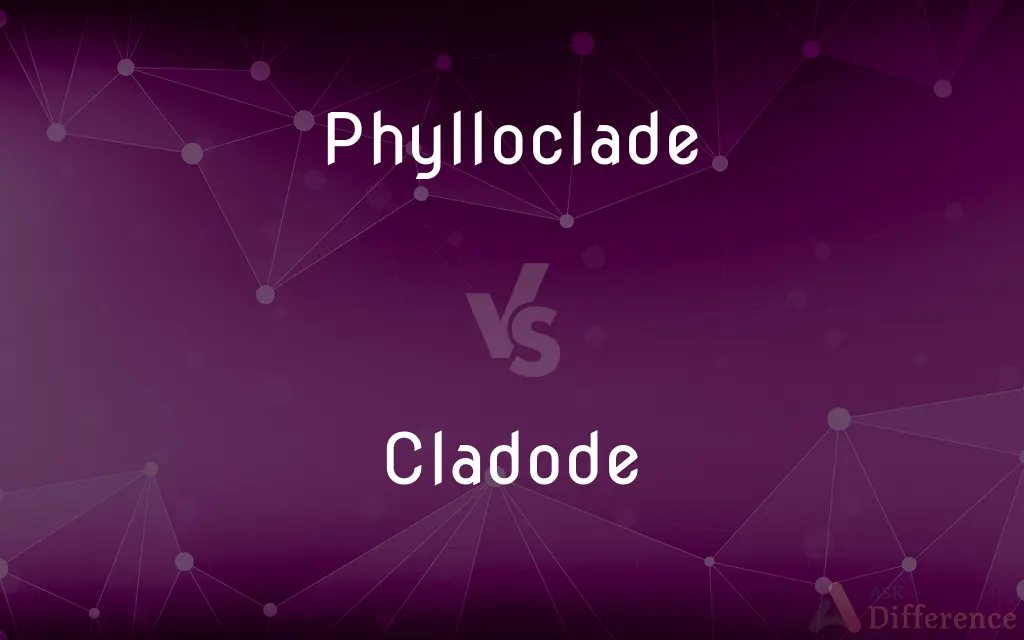Phylloclade vs. Cladode — What's the Difference?
By Maham Liaqat & Fiza Rafique — Updated on April 26, 2024
Phylloclades and cladodes are both modified stems adapted for photosynthesis in arid environments; phylloclades involve longer segments of the stem, while cladodes typically refer to shorter segments resembling or taking the place of leaves.

Difference Between Phylloclade and Cladode
Table of Contents
ADVERTISEMENT
Key Differences
Phylloclades are specialized plant structures where entire sections of a stem modify to function similarly to leaves, generally to perform photosynthesis in environments where water conservation is critical. In contrast, cladodes are also modified stems but usually consist of smaller, leaf-like sections that perform similar functions.
Phylloclades, such as those found in the cactus family, tend to be larger and can encompass several internodes of a stem, effectively replacing the plant's leaves. On the other hand, cladodes are typically smaller, involving only one or two internodes, and often appear more leaf-like in structure and function.
The adaptation seen in phylloclades typically involves a broader modification of the plant's architecture, often leading to significant changes in overall plant morphology. Cladodes, while also adaptive for reducing water loss and maximizing photosynthetic efficiency, usually mimic the shape and size of leaves more closely.
In terms of examples, plants like the Christmas cactus utilize phylloclades to perform photosynthesis and store water. Conversely, plants like the asparagus use cladodes, which are small, flat sections of the stem that assume the role of leaves, allowing the actual leaves to reduce to tiny scales and minimize water loss.
The ecological roles of phylloclades and cladodes are essentially similar, focusing on survival in arid or nutrient-poor environments by reducing transpiration and efficiently capturing sunlight. However, the specific morphological adaptations can affect how each plant interacts with its environment, with phylloclades often supporting larger and more robust structures compared to the finer, more delicate cladodes.
ADVERTISEMENT
Comparison Chart
Size and Structure
Larger, encompasses several internodes
Smaller, typically one or two internodes
Appearance
Broader segments, less leaf-like
More leaf-like, mimics leaves in form
Function
Photosynthesis, water storage
Photosynthesis, minimizes water loss
Typical Examples
Christmas cactus
Asparagus
Morphological Role
Replaces larger sections of the stem
Replaces specific parts resembling leaves
Compare with Definitions
Phylloclade
A modified stem adapted for photosynthesis in certain arid plants.
The phylloclade of a cactus is thick and fleshy, aiding in water retention.
Cladode
Usually involves only a few internodes.
Each cladode is limited to a small segment of the stem, optimizing leaf-like functionality.
Phylloclade
Can be large and robust, contributing to the plant's overall form.
The phylloclade not only aids in photosynthesis but also provides structural support to the plant.
Cladode
A small, leaf-like stem modification in certain plants.
The cladode of an asparagus plant resembles a thin, green leaf.
Phylloclade
Seen in plants adapted to extremely dry environments.
Phylloclades help desert plants survive by minimizing water loss.
Cladode
Acts primarily in photosynthesis while resembling leaves.
Cladodes enable the plant to carry out photosynthesis without large, water-consuming leaves.
Phylloclade
Replaces the photosynthetic function of leaves.
In plants with phylloclades, traditional leaves are often absent or reduced to spines.
Cladode
Common in nutrient-poor or water-limited environments.
Cladodes are an adaptation to reduce water loss while maintaining necessary photosynthesis.
Phylloclade
Typically involves multiple stem segments.
The phylloclade structure allows for efficient photosynthesis across a broader surface area.
Cladode
A photosynthetic branch or portion of a stem that functions as or resembles a leaf, as the pad of a prickly-pear cactus. Also called cladophyll.
Phylloclade
Phylloclades and cladodes are flattened, photosynthetic shoots, which are usually considered to be modified branches. The two terms are used either differently or interchangeably by different authors.
Cladode
(botany) A flattened organ arising from the stem of a plant, often replacing the leaves in photosynthetic function, as leaves in such plants (for example asparagus, butchers broom) are typically reduced to scales.
Phylloclade
A flattened, photosynthetic branch or stem that resembles or performs the function of a leaf; a cladode.
Cladode
A generally flattened shoot as of certain cactuses.
Phylloclade
(botany) A flattened stem, a type of cladode that has unlimited extension growth and resembles a leaf.
Cladode
A flattened stem resembling and functioning as a leaf.
Phylloclade
A flattened stem resembling and functioning as a leaf
Cladode
A flattened stem resembling and functioning as a leaf
Cladode
Often delicate and less structurally significant.
While functional, cladodes do not contribute much to the structural integrity of the plant.
Common Curiosities
Are cladodes and phylloclades exclusive to any particular plant families?
While not exclusive to any one family, these adaptations are more common in plants like cacti (phylloclades) and asparagus (cladodes) that thrive in challenging environments.
What is the primary function of phylloclades and cladodes?
Both phylloclades and cladodes primarily serve to perform photosynthesis while minimizing water loss in arid environments.
Why do some plants develop phylloclades instead of leaves?
In extremely arid environments, reducing leaf surface area through modifications like phylloclades helps minimize water loss.
Is there a difference in the care requirements for plants with phylloclades versus those with cladodes?
Plants with phylloclades may require less frequent watering and can store more water, whereas plants with cladodes might need more precise care depending on their water and light needs.
How do phylloclades differ morphologically from cladodes?
Phylloclades are larger and cover more stem internodes, while cladodes are smaller and more leaf-like.
How do phylloclades and cladodes impact the plant's overall survival?
They enhance survival by adapting to environmental stresses such as drought and nutrient scarcity, enabling the plant to thrive with reduced water use.
How do phylloclades and cladodes contribute to a plant's reproductive success?
By optimizing water use and maximizing photosynthetic efficiency, these adaptations help ensure that the plant can grow and reproduce even in less-than-ideal conditions.
Can both phylloclades and cladodes store water?
Phylloclades often store water due to their thicker, fleshier makeup, whereas cladodes generally do not specialize in water storage.
How do scientists study the evolutionary advantage of phylloclades and cladodes?
Through ecological and evolutionary biology studies, scientists assess how these features have allowed plants to adapt to and thrive in their specific environments.
What are the environmental advantages of having cladodes?
Cladodes offer the advantage of reduced water loss while maintaining essential photosynthetic capabilities in environments where water is scarce.
Can the presence of cladodes or phylloclades affect a plant's growth rate?
These adaptations may slow down a plant's growth rate due to limited leaf area and altered photosynthetic dynamics, focusing more on survival than rapid growth.
What typical problems might plants with these adaptations face in non-arid environments?
In more humid or cooler environments, these adaptations might lead to issues such as fungal infections or over-watering, as these plants are primarily adapted for dry conditions.
Share Your Discovery

Previous Comparison
Sales vs. Turnover
Next Comparison
Prosperous vs. HappyAuthor Spotlight
Written by
Maham LiaqatCo-written by
Fiza RafiqueFiza Rafique is a skilled content writer at AskDifference.com, where she meticulously refines and enhances written pieces. Drawing from her vast editorial expertise, Fiza ensures clarity, accuracy, and precision in every article. Passionate about language, she continually seeks to elevate the quality of content for readers worldwide.














































